Today on the ThermoWorks blog we’re honored to host Cameron Treu, owner of Bam Bam’s BBQ in Orem, Utah and competitive pitmaster. We love eating anything from his restaurant and he loves using our thermometers, so we thought we’d have a chat with him and let you in on some of his secrets.
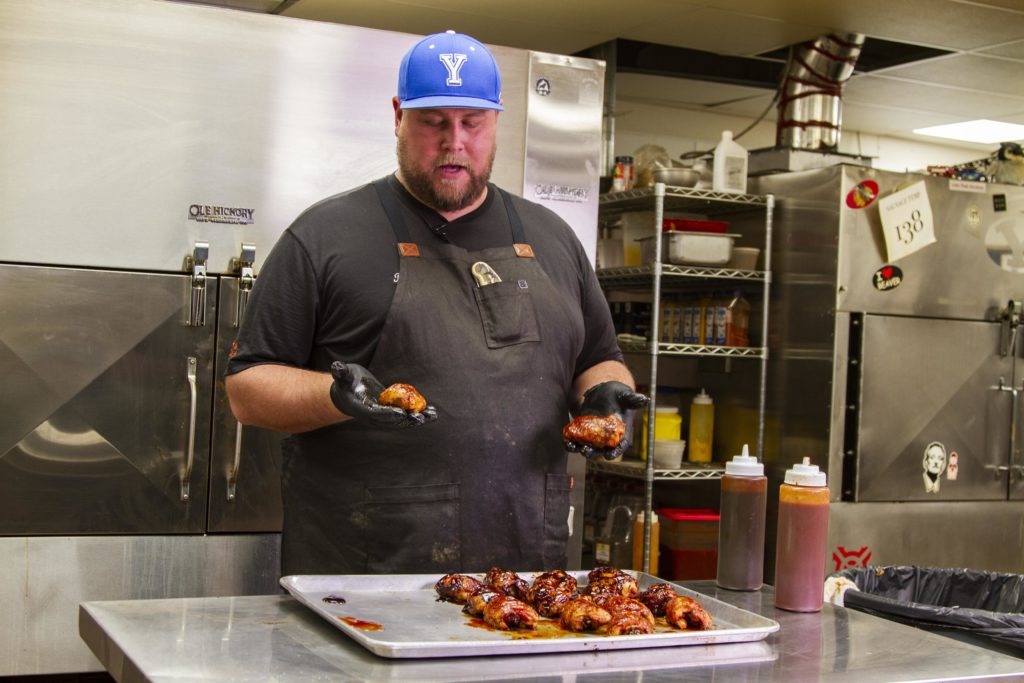
For this post, Bam Bam let us in on his tips for competition-winning BBQ chicken thighs, as well as two other methods for prepping them and talks about how he uses his Thermapen® to temp them just right, no matter the method.
So join us as we learn about some award-winning chicken from an all-around great guy.
Chicken Thigh Challenges
“Competition BBQ is about one bite,” Bam Bam says. The judges have a lot to eat and aren’t going to take more than one bite from each tray, so you have only one bite to get the best score from each judge. But chicken thighs have lots of unpalatable extra fat on the meat, some gristly bits, and skin that can be flabby and chewy.
Compound these anatomical difficulties with some pretty narrow temperature margins, and you have a meat that can baffle even the best pitmasters.
(Why chicken thigh? The dark and the light meat in chicken cook in fundamentally different ways. Light meat is lean and naturally tender, while the dark meat of the wings, legs, and thighs is fattier and more full of connective tissue—especially collagen. That’s why it can be so difficult to hit the sweet spot between rubbery and dry.)
How to trim chicken for BBQ gold
To get best results with chicken thighs, you need to trim them.
- The Mother-in-law level is the easiest, lowest effort that results in acceptable chicken.
- Neighbors get a little more effort and finesse, and take a little bit more work.
- New Girlfriend/Boss gets the most show-off effort. This is the level
that Bam Bam turns in at competitions .
Let’s examine them each in turn.
Basic (Mother-in-law) Trim
The Mother-in-law preparation is simple: apply rub to the bottom of the thigh, turn it over and apply it to the skin on the top side. Then grab the corners of the meat and skin that lay flabbily on the table. Fold the skin under the thigh, trying to leave no prints in the rub. Quickly trim any loose bits off, if you like. It’s quick, it’s easy, it won’t win any awards…but it still looks pretty nice and by tucking the skin under, you make the piece more uniform so that it

Medium (Neighbor) Trim
If you want to create a more impressive chicken thigh—perhaps for a neighborhood cookout—but you don’t wave the time to apply the full competition prep to every thigh, Bam Bam recommends taking things a step or two further than for the Mother-in-law.
First, he says, pull the skin as far off the thigh as you can. It will stick along a seam of fat, so slice through that seam gently with a sharp knife to free the skin completely. With the skin removed, “cut anything off the meat itself that you aren’t going to eat,” he says.
Bam Bam trims off the fatty bits that cling to the meat. With the short length of this cook, he says, you won’t be rendering any blobs like that.
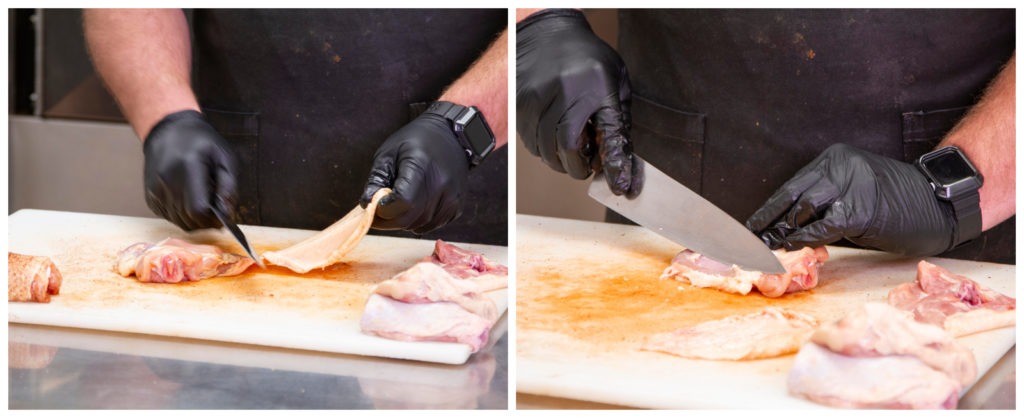
Once
The skin also gets a little more treatment in the Neighbor trim: Spread it out and, with your knife at a nearly flat angle, trim any high spots off of the fatty side by keeping the blade moving and letting the edge to the work so you don’t tear the skin

Before rewrapping, you need to season the meat. Season both sides of the meat with a good rub.
Once the meat is seasoned, wrap the thigh in skin, tucking it together on the bottom. “Some guys use toothpicks to hold it together,” he says. “Some guys even use meat glue”—his eyes roll and he scoffs—“but the day I need to use meat glue to compete, I’m done.” He simply lets the skin adhere to the meat, knowing there will be some shrinkage.
Trim away the extra skin so that when it is re-wrapped onto the meat there is enough to cover the edible portion and overlap just a little bit. With the skin in place, season the piece lightly again, being careful to avoid smudging the rub.
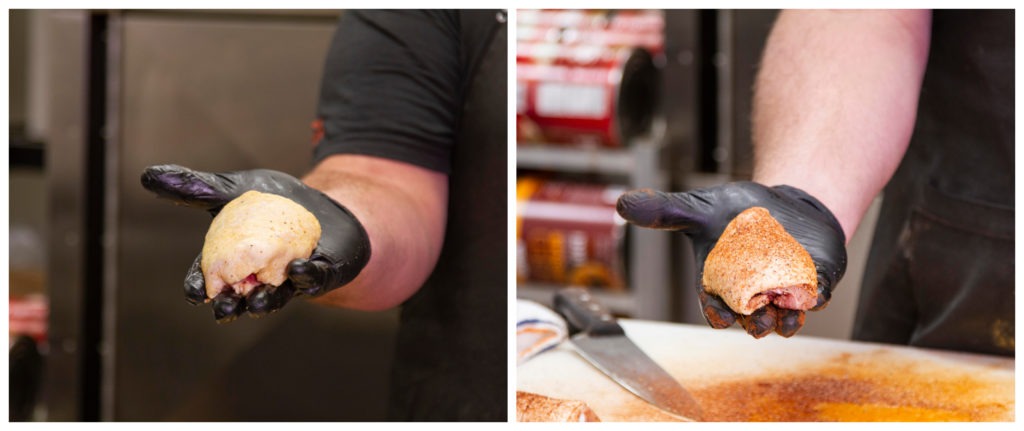
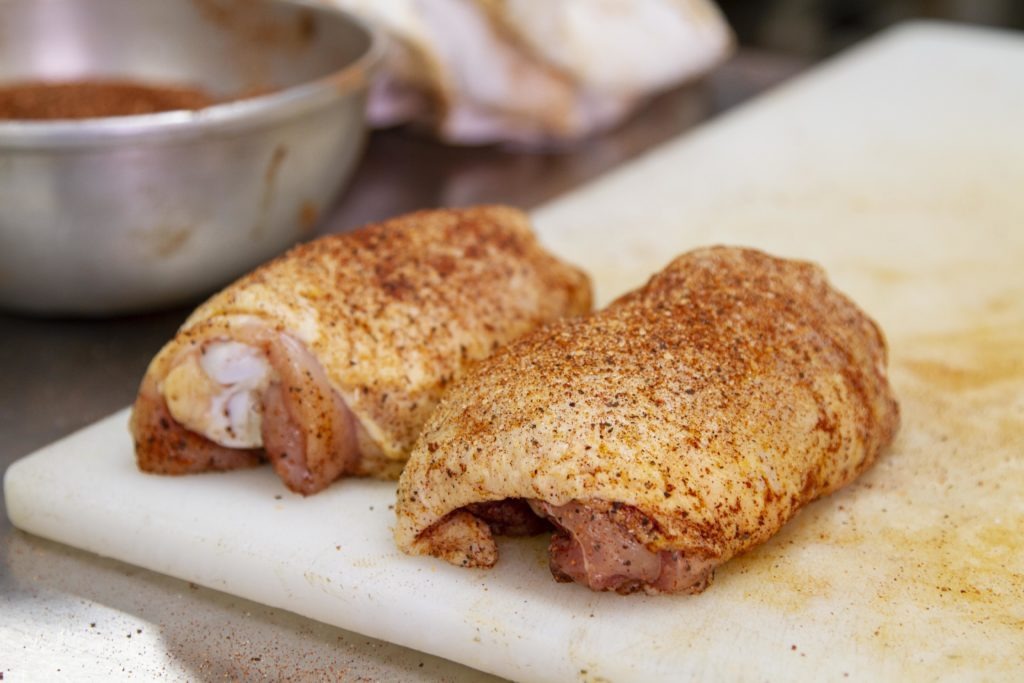
This method gives you uniform, nice, even chicken with no gristly bits to interrupt your enjoyment. Certainly something you’d be proud to serve your neighbors. But there is yet one more level of chicken BBQ perfection to achieve…
Competition (Girlfriend/Boss) Trim
Competition trim starts like the neighbor trim by removing the skin completely from the thigh. When prepping for a competition, Bam Bam emphasizes that just because this piece of skin came from this thigh doesn’t mean it has to go back on this thigh. If a large thigh has barely enough skin to cover it and a small thigh has way too much, go ahead and trade skins around.
With the skins removed, Bam Bam’s next move is to “knock down the high spots” with his knife laid almost perfectly flat against the skin. You need a very sharp knife to avoid tearing the tender skin, he says. He points out that chicken skin itself is quite translucent, letting a good deal of light through. If your skin is quite opaque then it has a lot of fat on it. Bam Bam does not recommend scraping all of that fat off, only the high spots, but he has a trick for getting crisp, un-flabby skin that we’ll come to later.
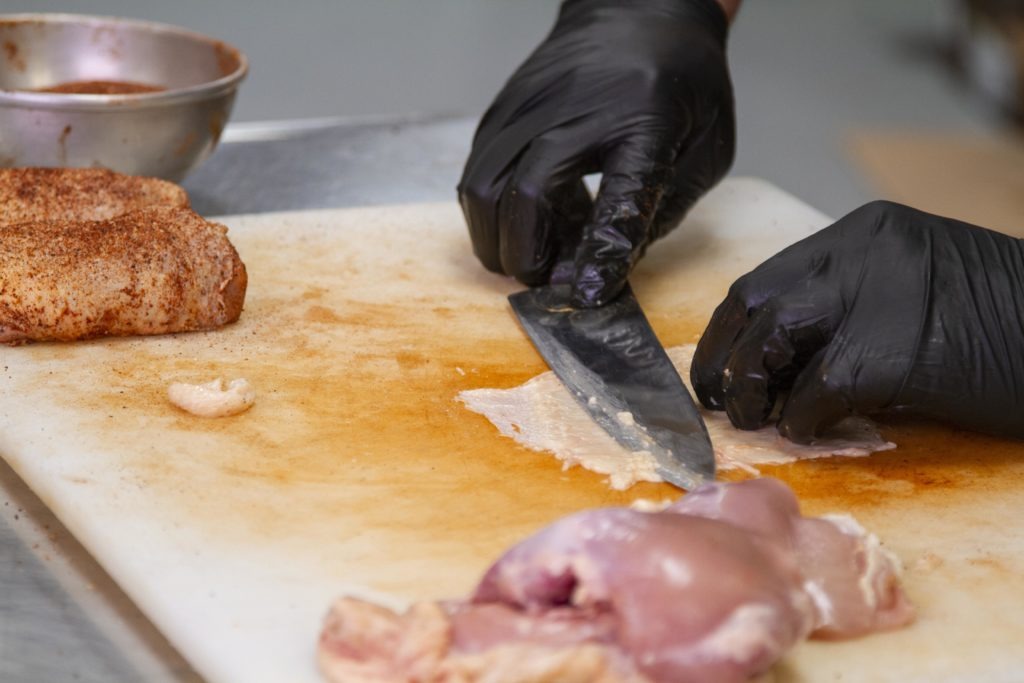
Once the skins are taken care of, trim the meat. Remove the same fatty and gristly bits that we removed for the Neighbor cut, and square off the meat along the sides. If there are any obvious veins in the meat, trim them out with a sharp knife, and inspect the chicken for anything that could be seen as interrupting a ‘perfect’ bite.
To make a more uniform piece, and to make pieces that are small enough to fit six to a box for the judges, Bam Bam cuts the knuckle of the thigh bone off. “Find this little line of fat,” he says, and cut the knuckle off along that line. “Some guys use garden shears, me, I just…” (at this point Bam Bam placed the knife edge where he wanted to cut the bone, and pounded the spine with his other hand, popping the knuckle clean off.)
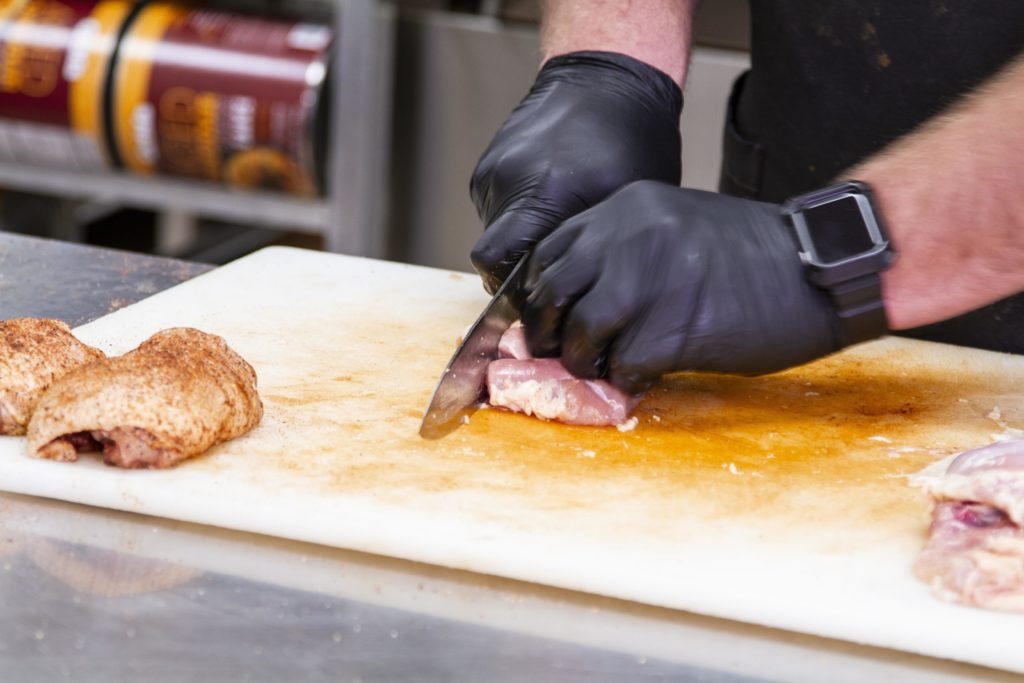
While preparing the thighs for actual cooking, Bam Bam talked a little bit about competitions and judging. Emphasizing the “one-bite” judging that happens, he holds up a thigh, demonstrating that there is a meatier side of the bone and a less meaty side. “I’ll put that side facing the judges,” he says. Most people, he says, just pick it up and take a bite without turning it around or anything, so that first bite can be improved by positioning it correctly in the turn-in box.
To make sure the very best chicken gets turned in, he says that he’ll cook 10-12 thighs if six are to be turned in. That way the best looking, best-done pieces can be used. But, he says, “if it’s cooked right and tastes good, you’re gonna beat 80% of the competition…taste is the biggest score” on the scorecard.
To season the pieces, Bam Bam will hold each piece in one hand while

The result is a rectangular, compact, completely uniform piece of chicken that is going to cook evenly and present nothing but perfection on the first bite.
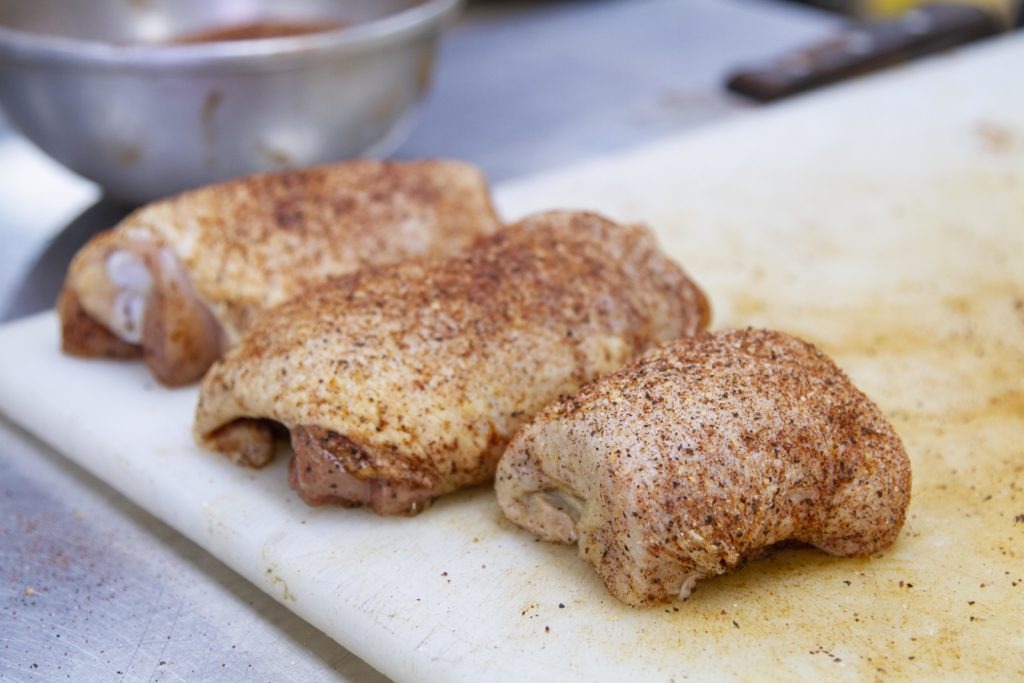
How to cook chicken thighs for BBQ competition
Just as there are different measures of care that can be taken in trimming, there are different levels of complexity that can go into the cooking. But all of them depend on correct temperatures and those temperatures are higher than some people might expect. BBQ chicken thighs should not just cook them to the “chicken is ready to eat” temperature of 165°F (74°C), but to a “connective tissues are broken down now” temperature of around 175°F (79°C). Often the dark meat is left with a rubbery, chewy texture that can be off-putting to many. But if you properly cook the meat, it becomes tender with an almost silky bite that is very enjoyable. This critical temperature will give you tender, juicy, delicious chicken thighs that will wow your friends, and could even win you
The Butter Trick
Now we come to the trick Bam Bam uses to avoid having to trim every bit of fat from the chicken skin. To start, he cooks all the chicken thighs upside down for about 45 minutes in a foil pan with about a ¼–½ inch of butter in the bottom. Cooking them in butter like that allows the fat under the skin to more fully render than if you were to just put the thighs directly in the smoker.
After 45 minutes of cooking in the butter, Bam Bam lets the thighs cool a little in the tray, resting them for 15 minutes, before putting them into the smoker again. He runs his smoker for chicken between 275 and 300°F (135 and 149°C), hot enough to get a little color on the meat and to cook it more quickly. Though Bam Bam emphasizes that you can’t rely on times for BBQ, he says the final cook takes about 45 more minutes. The chicken goes in straight on the rack at this point, no foil, no wrap. He cooks the chicken to 175°F (79°C) in its fattest part, checking the temps with his Thermapen.
(If that temp seems high to you, you should read our comprehensive post on chicken temperatures!)
Saucing the Chicken
Once the chicken has come to temp, he takes it out and gives it a coat with some good BBQ sauce. “If you want to give it a sheen,” he says, “heat your sauce up in a pan and add a little butter to it so it gets shiny.” Then use tongs to dunk the pieces, coating them completely. If you’re just doing this at home for dinner, that kind of care isn’t necessary and you can just brush or smear the sauce on, but in competition, the details can help you beat that other 20% of the crowd. Either way, though, sauce the thighs while they’re hot, as the heat will help the sauce coat them more evenly.
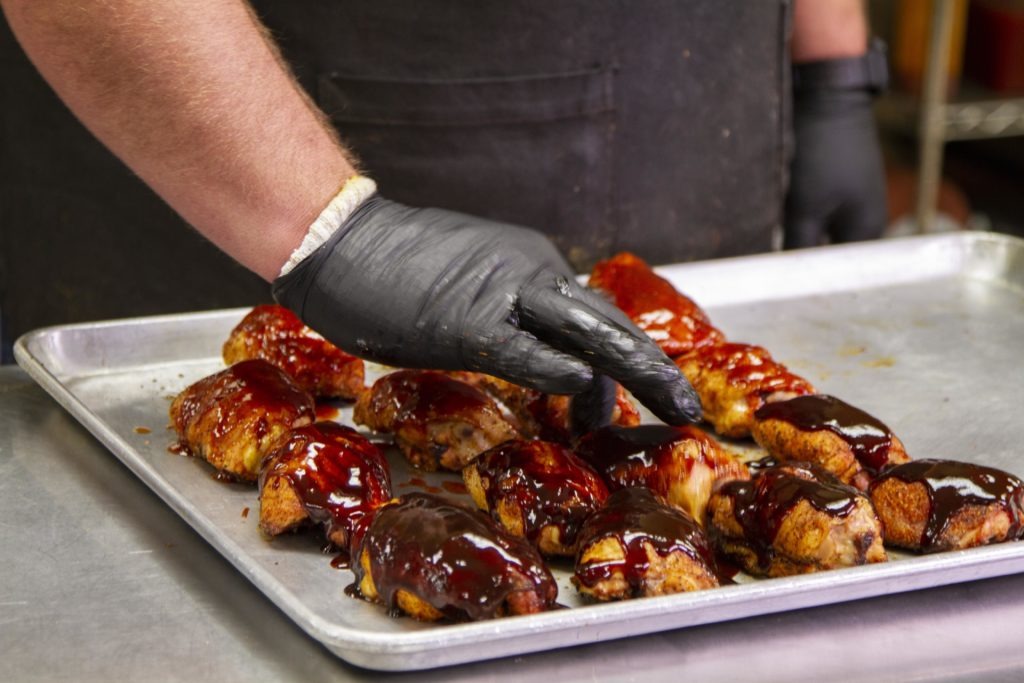
Once the chicken is wells sauced, Bam Bam tosses them back in the smoker for about 10 minutes to ‘set’ the sauce. That’s ok from a thermal angle, he says, “because the sauce cools the meat slightly.”
Once the sauce is set, Bam Bam lets the chicken rest, tented under loose foil, for another 10 minutes for the juices in the meat to settle down and redistribute. Then, off it goes to the judges!
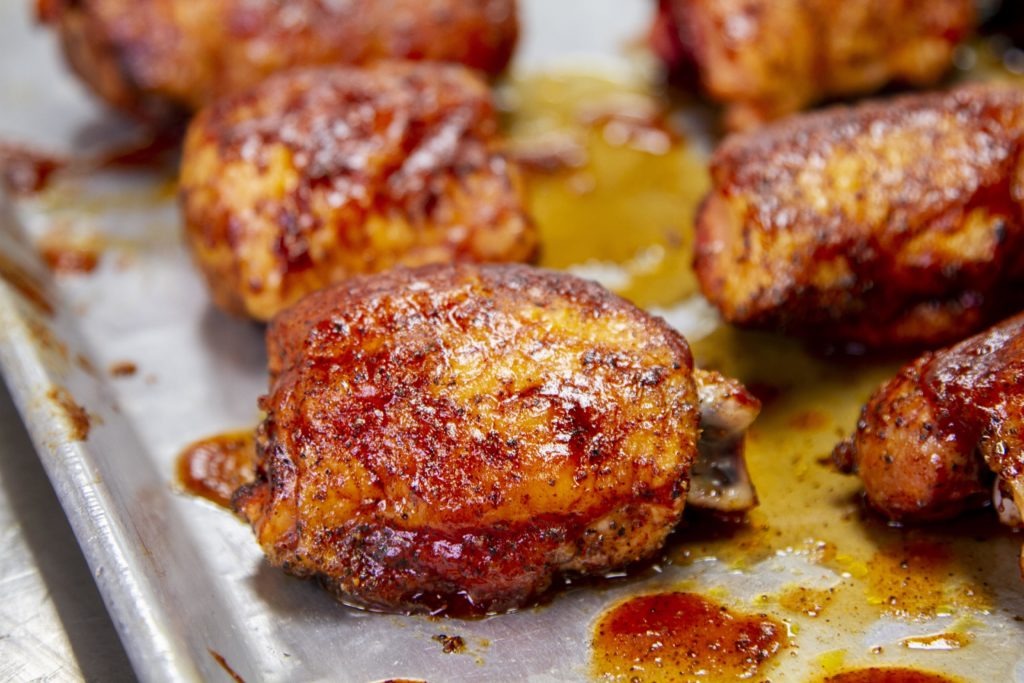
In the end, all these steps come together to create
Now, if you don’t want to go through the trouble of butter-bathing your chicken, that’s fine, too.
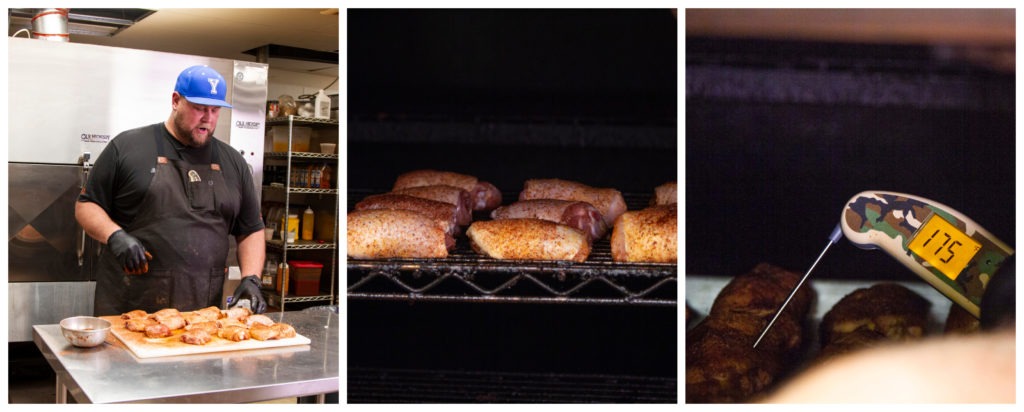
BBQ Chicken Thigh Recipe
Bam Bam has years of experience in competition as well as BBQ restaurants, so he knows a lot about when chicken is done. For that reason, he relies solely on his Thermapen. Most home cooks and beginning BBQ-ers should monitor the internal temperature of the chicken throughout the cook. In this recipe, we’ve included
Ingredients
- 8 Chicken thighs, bone-in, skin on
- ~6 Tbsp of your favorite chicken BBQ
rub - 1–2 C your favorite BBQ sauce for chicken
- 1 lb butter, plus a tablespoon for the sauce
Instructions
- Preheat smoker to 300°F (149°C)
- If you want competition-style thighs, trim them by removing the skin, cutting off any high-spots of fat from the inside of the skin, squaring up the meat and trimming off excess fat, and removing the ball joint of the bone.
- Sprinkle the meat lightly but evenly with the rub.
- Re-wrap the meat in the skin and sprinkle with more rub.
- Even if you don’t do all the trimming, it’s a good idea to peel the skin back and sprinkle some rub underneath it. Skin is designed to keep things out. Put some rub under it to flavor the meat better.
- Cut the butter up into small cubes and put it all in the bottom of an aluminum pan that is large enough to fit all the chicken in one layer.
- Layer the chicken, seam-side up, on the butter. Cover it with foil and put it in the smoker for 45 minutes.
- After 45 minutes has elapsed, remove the chicken pan from the smoker and let it sit for 15 minutes.
- Remove the chicken from the pan and place it back in the smoker, inserting a Pro-Series® Probe attached to a leave-in thermometer such as BlueDOT®, ChefAlarm® or Smoke™. Set the high alarm for 175°F (79°C) and smoke the chicken.
- Warm your barbecue sauce on the stove or in the smoker for a few minutes. Stir in the tablespoon of butter and remove the sauce from heat.
- When the alarm sounds, verify the temperature with your Thermapen, then baste the chicken with the BBQ sauce. Alternatively, you can lift each piece and dunk it in the sauce before returning it to the smoker.
- Cook the chicken for a final 10 minutes to set the sauce.
- Remove the chicken from heat, allow to rest for 10 minutes and serve.
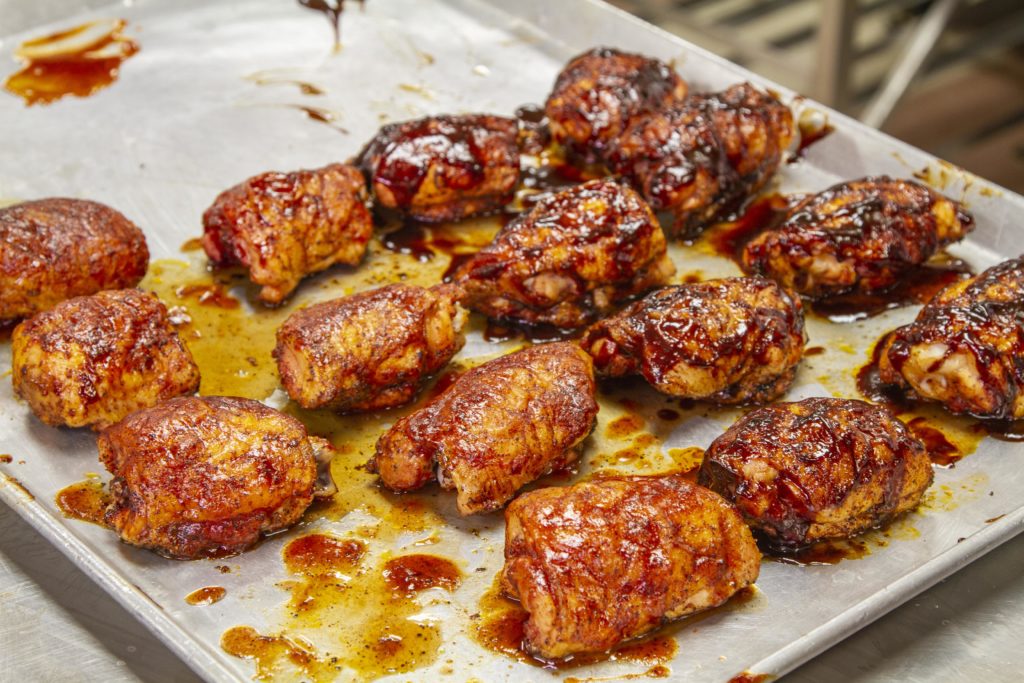
That’s how you make award winning BBQ chicken. It’s simple, it’s cheap, and by using your Thermapen to nail the 175°F (79°C) critical temperature, it’s bound to be delicious!
Shop now for products used in this post:
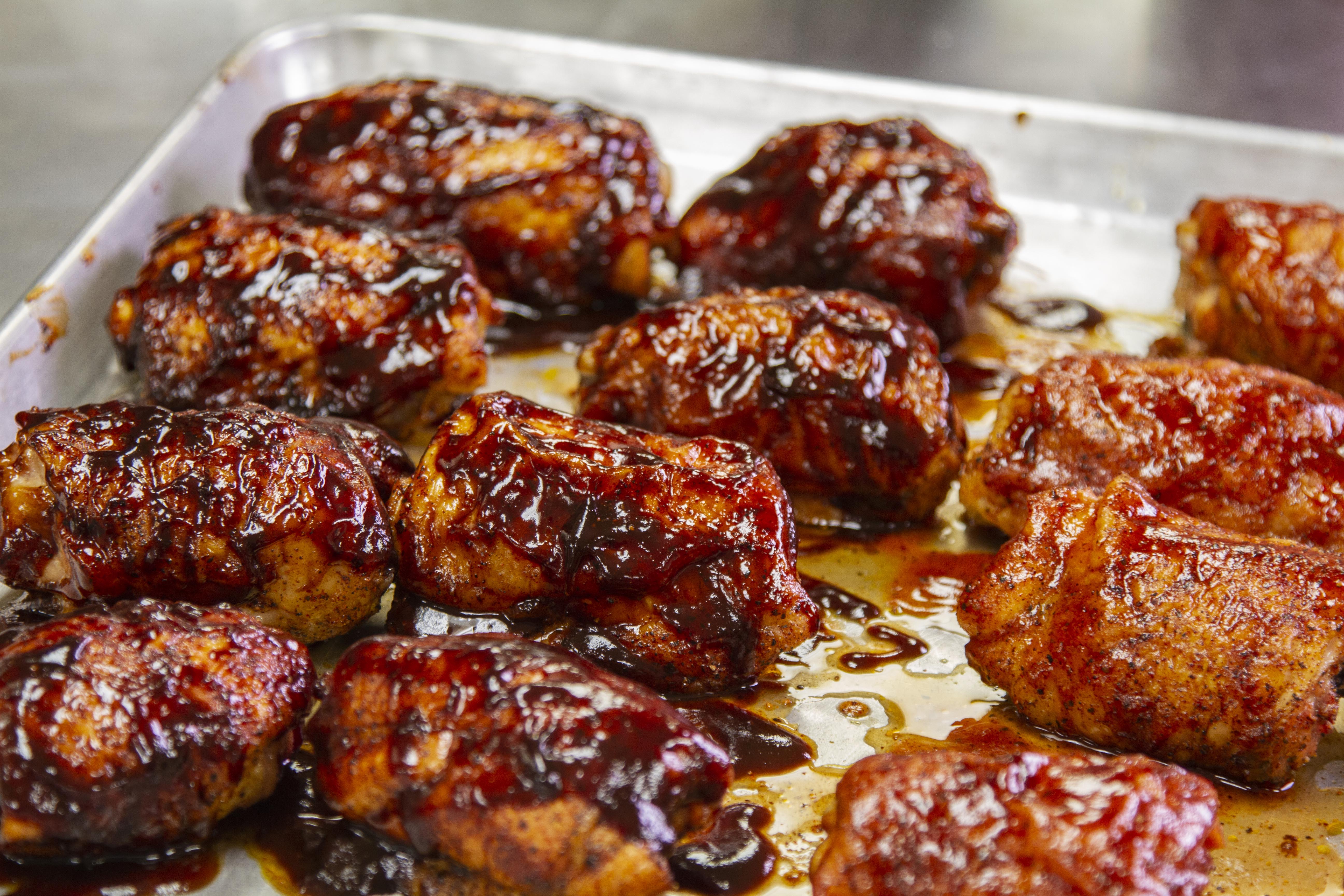

Stan Janiec says
That is really neat. I can’t wait to try it. We love thighs and BBQ them often.
Mike Poole says
I wouldn’t take any advice from someone that doesn’t know that chicken wings are a light meat and not a dark meat. Read the last paragraph under Chicken Thigh Challenges!
Martin says
Chicken wings are technically white meat because they come from non-migratory birds that only fly in short bursts. But according to America’s Test Kitchen:
“Wings…have the highest proportion of skin compared to other chicken parts, and that skin is 60-80 percent collagen. When that collagen reaches 135 degrees, it begins to convert into gelatin, the gel-like substance that provides tenderness and moisture-holding capacity in many meats. The collagen helps retain moisture in the meat as it cooks, keeping it more juicy and tender. This is extremely helpful when it comes to cooking wings: This extra gelatin provides the perception of juiciness thanks to its moisture-holding capacity…
Chicken wings may be technically white meat, but because they are almost as fatty as the legs and thighs and contain a good deal of collagen, they can handle higher temperatures like dark meat.”
If you cook wings like white meat they’ll be chewy and rubbery. Treat them like dark meat and they come out deliciously tender and shreddy.
Bkhuna says
Use a vortex full of briquettes in a kettle and put the mother in law thighs around the edge of the grill. They will become surprisingly crispy.
carrie says
This was a fascinating read! i really enjoyed reading the 3 trimming/cooking versions.
mark schneidman says
Great job! I learned a lot. One question: was it intentional or an oversight that the thighs in the competition version were not seasoned with dry rub on the meat first and then again on the skin? Can’t wait to try this…thank you.
Martin says
I couldn’t say if it was intentional or not, but it’s what our guide taught! Adding rub under the skin is a great idea and a perfect way to layer flavors. Go for it!
Patty Ibbetson says
How would you make this if you don’t have a smoker?
Martin says
Follow all the same temperature advice, but use your oven instead of the smoker. If you want smoke flavor, add a little liquid smoke to the braise or use a rub with a lot of smoked paprika or chipotle.